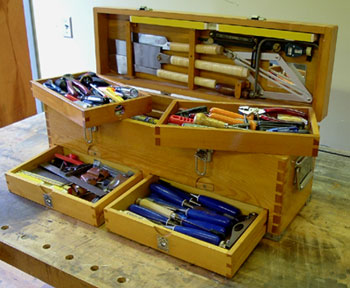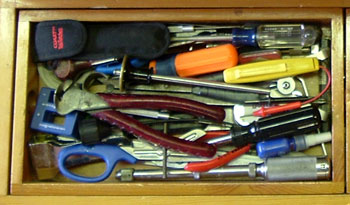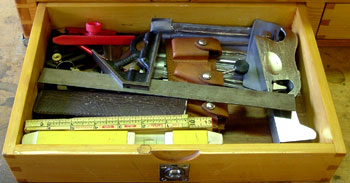Job Box Tool List, Part I
by Chris Black
 For many years before coming to Highland, I worked as a carpenter/cabinetmaker in the historical districts of Washington D.C. and Alexandria, Virginia. A friend from England who worked with me called us "joiners". Historical restoration and remodeling isn't much different from other work, you just have to be more conscious of period details and have a reverent attitude during demolition. In many instances you are forced to use hand tools where you would normally use a reciprocating saw or a hammer drill. You must be constantly aware of the effect that noise, dust and vibration have on the immediate environment. Often there's no space to set up power tools, so you must rely heavily on hand tools and hand skills. Needless to say, over time I've collected an interesting array of hand tools to tackle some fairly intricate tasks.
For many years before coming to Highland, I worked as a carpenter/cabinetmaker in the historical districts of Washington D.C. and Alexandria, Virginia. A friend from England who worked with me called us "joiners". Historical restoration and remodeling isn't much different from other work, you just have to be more conscious of period details and have a reverent attitude during demolition. In many instances you are forced to use hand tools where you would normally use a reciprocating saw or a hammer drill. You must be constantly aware of the effect that noise, dust and vibration have on the immediate environment. Often there's no space to set up power tools, so you must rely heavily on hand tools and hand skills. Needless to say, over time I've collected an interesting array of hand tools to tackle some fairly intricate tasks.
Many folks ask me what hand tools they need to get started in woodworking. In this series of articles, I've gone through and listed my personal tools for different types of site woodworking or woodworking outside your primary shop. I hope it helps you. I eventually wound up with three toolboxes with different sets of tools to handle the types of work required on different jobs. One box houses various handplanes that can be swapped out as the situation dictates. Another is dedicated to general carpentry, and the third to cabinetry and cabinet installation. These boxes are invaluable especially when working in someone else's shop. Oh sure, most shops have all the necessary machinery and supplies, but things like chisels, squares and planes are too personal to borrow.
In this first article, I'll list the tools in my carpentry box, and make comments on some of the more interesting ones. Use it as a starting point for your own collection. Print it out and add to it as you see fit. You've heard it before, but I'll say it again: Always buy the best tools you can afford, and if you can't afford the best, wait until you can. Some tools aren't made anymore or are difficult to find. Keep at it. If you really need it, tools have a way of finding you just before you need them. You'll notice I've listed tools from other trades as well. All I can say is that you'll never know what you'll run into on a job, and it pays to be prepared.
IN THE LID
-
 Ryoba
- a two-sided Japanese saw capable of ripping and crosscutting.
Ryoba
- a two-sided Japanese saw capable of ripping and crosscutting.
-
Dozuki
- a Japanese backsaw
-
Azebiki
- a Japanese saw for starting a cut in the middle of a panel.
-
Coping saw
-
24" level
- attaches to the lid with magnets.
-
Moulding and log scribe
-
Angle divider
- gives you angle cuts for inside and outside miters.
-
A mirror
- one must look presentable. It is the King's trade after all.
TOP TRAYS
-
 Yankee push drill
- good ones are getting hard to find.
Yankee push drill
- good ones are getting hard to find.
-
End nippers
- for cutting nails close to the surface.
-
Multi-tipped screwdriver
-
Needle-nose pliers
-
Side cutters
-
Torx set
-
Hex (Allen) set
-
Long #2 Philips screwdriver
- for securing bi-fold door hardware.
-
Marking gauge
-
Telescoping magnet
- retrieves fumbled screws and such from behind stoves and radiators.
-
4- in-1 square drive screwdriver
-
SAE/metric thread gauges
-
2 nail spinners
- "burns" nails in without splitting hardwoods. You need two because one will get borrowed and never returned.
-
Spring-loaded center punch
- a safe way to break glass.
-
3 nail sets
-
Small pry bar
-
Medium pry bar
-
Small tack lifter
-
 12" dividers
- for laying out stair stringers (carriages) in places before modern codes.
12" dividers
- for laying out stair stringers (carriages) in places before modern codes.
-
Putty knife
- I've never actually had to use one (yeah, right).
-
Adjustable wrench
-
Dental picks
- used to clean the crud out of carvings and millwork details.
-
3-prong power cord adapter
-
Tapered reamer
- enlarges holes in old hardware.
-
Tweezers
- don't you just hate splinters?
-
Small calculator
- carpenters are notoriously bad at math.
-
Deburring tool
- cleans up hardware that's not quite right.
-
Set of jeweler's screwdrivers
-
Offset ratcheting screwdriver
- essential for repairing casement windows and working transom hardware.
RIGHT DRAWER
-
 6' folding rule
6' folding rule
-
6" torpedo level
-
6" architect's rule
- occasionally you'll need to scale a drawing when no one's looking.
-
12" steel rule
-
Pinch dogs
- spring pinch clamps hold miters joints together while the glue dries.
-
Pliers for pinch dogs
- for releasing the hounds so they don't scratch the millwork.
-
Bevel and protractor
-
Small bevel
-
Plumb bob and line
-
12" combination square
-
Scratch awl
-
Counter scribe
- for scribing counter tops to irregular walls.
-
Pencil compass
-
Set of gimlets
- for starting screw holes.
-
Saddle Square
- helps transfer lines around corners.
-
Set of Collins Bunny Planes
- finger planes for coaxing uncooperative moulding into alignment (highly recommended).
LEFT DRAWER
-
 3/4" shoulder plane
- an essential tool for fitting new stools and sills to old windows.
3/4" shoulder plane
- an essential tool for fitting new stools and sills to old windows.
-
Low angle block plane
- standard angle block planes don't fit in your pocket as well.
-
Coarse rifflers
- help blend scarf joints in handrails and moldings.
-
Needle file set
-
Bench chisels
- 1/8", 1/4", 3/8", 1/2", 5/8", 3/4" and 1"
LOWER TILL
-
 Contour gauge
- transfers a negative image of an item to be matched.
Contour gauge
- transfers a negative image of an item to be matched.
-
Pry bar
-
Cat's paw
- digs buried nails out of boards.
-
Molding pry bar
- a very thin bar for delicately removing trim.
-
Battery powered stud sensor
-
Surform tools
- cheese grater type tools for shaping and smoothing Bondo and epoxy fillers.
-
Razor knife w/ extra blades
-
Coping saw blades
- store them a travel toothbrush holder to keep them from kinking.
-
Moulding shears
- cuts small trim without running to the saw.
-
6" combination square
-
Voltage tester
- sure beats two wet fingers.
-
Channel lock pliers
- you just never know.
-
Klein's
- also known as linesman pliers.
-
2 steel stud clamps
- holds steel studs in the metal track until the screws are set.
-
Butt mortise plane
- for setting strike plates, hinges and other flush mounted hardware.
-
Trammel points or beam compass heads
- for laying out arches and ellipses.
-
Codebooks extracts and cheat books
- wrap covers in shipping tape to prevent damage.
-
Keel holder
- keeps lumber crayons from breaking.
-
Small hammer
-
100' tape
-
25' back up tape
- eventually your tape measure will leap out of your hands when you are three stories up, and dash itself against the sidewalk.
-
Beater chisels
- sometimes you just have to get the job done.
-
Electric eggbeater attachment
- put one in a drill to mix small amounts of plaster, grout drywall compound and other dusty potions. Dollar stores are a good source for these.
-
Small Yankee screwdriver with various driver bits and drill bits
(if you can find them).
-
Draftsman's flexible curve
-
An extra 3-prong adaptor
-
Light socket plug
- many times folks forget to leave you a key and an exterior light socket may be your only source of power.
-
Brace and bits
- a far safer way to set full mortise hardware, entry latches and other complicated hardware.
-
Expansion bit
- for drilling passage door sets.
-
Tool roll with card scrapers, burnisher, files and spokeshaves
.
-
Hacksaw blade holder
-
Zip tool
- helps remove vinyl and aluminum siding without damaging it.
That's my basic carpentry hand tool list. If you're involved in any sort of remodeling, you'll eventually windup with tools from everyone else's trade. I guess that's the general part of general contracting. I have several bags full of plumbing tools, mechanical tools, plaster knives, concrete trowels, tile cutters and electrician's tools. Some jobs are too small to bring in a subcontractor, and sometimes you break something and need to fix it before anyone finds out. You get the picture.